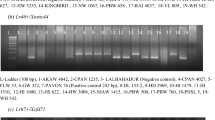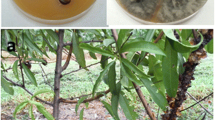Summary
As part of a project to assess the U.S. Asiatic Cotton Germplasm Collection as a source of genes for pest resistance, forty-three accessions of Gossypium arboreum L. were evaluated for resistance to thrips. Thrips, Thysanoptera spp., are a minor, but widespread pest on cotton, G. hirsutum L. and G. barbadense L. Accessions were planted in free-choice field tests in 1988, 1989, and 1990 at the Cotton Branch Experiment Station, Marianna, Arkansas. Damage ratings, based on a scale of 0 (no damage) to 7 (severe damage), were made approximately one month after planting. Relative score was computed by dividing the rating of each accession by the rating of the reference, G. hirsutum ‘Stoneville 506’. The relative score averaged over all G. arboreum accessions by year varied with the year, but was less than 100 (relative score for Stoneville 506) in each case. When data were combined for all three years, twenty-five accessions were significantly better than Stoneville 506. Introgression of the better accessions into G. hirsutum is now in progress.
Similar content being viewed by others
Abbreviations
- NPGS:
-
National Plant Germplasm System
- STV 506:
-
G. hirsutum ‘Stoneville 506’
References
Ballard, W. W., 1951. Varietal differences in susceptibility to thrips injury in upland cotton. Agron. J. 43: 37–44.
Benedict, J. H., M. F. Treacy, D. W. Altman & K. M. Schmidt, 1987. Preference of boll weevils and tobacco budworms for five species of Gossypium. In: J. M. Brown (Ed.), Proc. Beltwide Cotton Prod. Res. Conf. 4–8 Jan, Dallas, TX. p. 94, Natl. Cotton Council of America, Memphis, TN.
Benedict, J. H., M. F. Treacy & J. C. Segers, 1986. Role of mixed planting of susceptible and resistant phenotypes on yield and fleahopper behaviour. In: J. M. Brown (Ed.), Proc. Beltwide Cotton Prod. Res. Conf. 4–9 Jan., Las Vegas, NV, p.p. 486–488, Natl. Cotton Council of America, Memphis, TN.
Bollenbacher, K. & N. D. Fulton, 1971. Susceptibility of Gossypium species and varieties to seedling anthracnose. Plant Dis. Rptr. 55: 879–882.
Cantelo, W. W. & L. L. Sanford, 1984. Insect population response to mixed and uniform plantings of resistant and susceptible plant material. Environ. Entomol. 13: 1433–1445.
Carter, W. W., 1981. Resistance and resistant reaction of Gossypium arboreum to the reniform nematode, Rotylenchulus reniformis. J. Nematol. 13: 368–374.
Carter, W. W., 1974. Histological responses of resistant and susceptible Gossypium arboreum to Rotylenchulus reniformis. J. Nematol. 3: 138.
Cochran, M. J., N. P. Tugwell, C. M. Danforth, F. Carter, S. J. Stringer & J. R. Phillips, 1989. Thrips control strategies and crop termination timing strategies: economic analysis of yield and fiber properties. In: J. M. Brown (Ed.), Proc. Beltwide Cotton Prod. Res. Conf. 2–7 Jan., Nashville, TN, p.p. 297–301, Natl. Cotton Council of America, Memphis, TN.
Daniel, W. W., 1990. Applied nonparametric statistics. 2nd ed. PWS-Kent, Boston MA.
Endrizzi, J. E., E. L. Turcotte & R. J. Kohel, 1984. Qualitative genetics, cytology, and cytogenetics. In: R. J. Kohel & C. F. Lewis (Eds.), Cotton, p.p. 82–131. Am. Soc. Agron. Madison, WI.
Fryxell, P. A., 1984. Taxonomy and germplasm resources. In: R. J. Kohel & C. F. Lewis (Eds.), Cotton, p.p. 27–58. Am. Soc. Agron. Madison, WI.
Hardee, D. D. & G. A. Herzog, 1991. 44th annual conference report on cotton insect research and control. In: D. J. Herber & D. A. Richter (Eds.) Proc. Beltwide Cotton Prod. Res. Conf. p.p. 583–601, Natl. Cotton Council of America, Memphis, TN.
Harlan, J. R. & J. M. J. de Wet, 1971. Toward a rational classification of cultivated plants. Taxon 20(4): 509–517.
Hightower, B. G., 1958. Laboratory study on the effect of thrips infestation on the height and weight of seedling cotton. J. Econ. Entomol. 51(1): 115–116.
Innes, N. L., 1966. Inheritance of resistance to bacterial blight of cotton. III. Herbaceum resistance transferred to tetraploid cotton. J. Agr. Sci. 66: 433–439.
Jenkins, J. N., 1982. Present state of the art and science of cotton breeding for insect resistance in the southeast. In: J. M. Brown (Ed.), Proc. Beltwide Cotton Prod. Res. Conf. 3–7 Jan., Las Vegas, p.p. 117–125, Natl. Cotton Council of America, Memphis, TN.
Johnson, D. R., J. J. Kimbrough & J. S. McConnell, 1989. The effect of variety of thrips control. In: J. M. Brown (Ed.), Proc. Beltwide Cotton Prod. Res. Conf. 2–7 Jan., Nashville, TN, p.p. 303–305, Natl. Cotton Council of America, Memphis, TN.
King, E. G. & G. A. Herzog, 1990. 43rd annual conference report on cotton insect research and control. In: J. M. Brown (Ed.), Proc. Beltwide Cotton Prod. Res. Conf. 9—14 Jan., Las Vegas, NV, p.p. 140–157, Natl. Cotton Council of America, Memphis, TN.
King, E. G. & J. R. Phillips, 1989. 42nd annual conference report on cotton insect research and control. In: J. M. Brown (Ed.), Proc. Beltwide Cotton Prod. Res. Conf. 2–7 Jan., Nashville, TN, p.p. 180–193, Natl. Cotton Council of America, Memphis, TN.
Leser, J. F., 1986. Thrips management: problems and progress. In: J. M. Brown (Ed.), Proc. Beltwide Cotton Prod. Res. Conf. 4–9 Jan., Las Vegas, NV, p.p. 175–178, Natl. Cotton Council of America, Memphis, TN.
Mathre, D. E. & J. D. Otta, 1967. A search for resistance in the genus Gossypium to soil-borne pathogens. In: Proc. Beltwide Cotton Prod. Res. Conf. 10–11 Jan., Dallas, TX, p. 54, Natl. Cotton Council of America, Memphis, TN.
Niles, G. A., 1980. Breeding cotton for resistance to insect pests. In: F. G. Maxwell & P. R. Jennings (Eds.), Breeding plants resistant to insects, p.p. 337–369, John Wiley and Sons, NY.
Painter, R. H., 1951. Insect resistance in crop plants. Macmillan Co., NY.
Percival, A. E., 1987. The National Collection of Gossypium Germplasm. Department of Agriculture & Commerce, Texas A&M University, College Station, Texas, Southern Cooperative Series Bull. 321.
Quisenberry, J. E. & D. R. Rummel, 1979. Natural resistance to thrips injury in cotton as measured by differential leaf area reduction. Crop Sci. 19: 879–881.
Rummel, D. R. & J. E. Quisenberry, 1979. Influence of thrips injury on leaf development and yield of various cotton genotypes. J. Econ. Entomol. 72: 706–710.
Santhanam, V. & J. B. Hutchinson, 1974. Cotton. In: J. B. Hutchinson (Ed.), Evolutionary studies in world crops, p.p. 89–100, Cambridge Univ. Press, Oxford.
Shelton, A. M., C. W. Hoy, R. C. North, M. H. Dickson & J. Barnard, 1988. Analysis of resistance in cabbage varieties to damage by Lepidoptera and Thysanoptera. J. Econ. Entomol. 81: 634–640.
Stanton, M. A. & J. McD. Stewart. 1988. Morphological diversity in the Asiatic cottons. In: Agron. Abstr. p. 96, Am. Soc. Agron. Madison, WI.
Stanton, M. A., N. P. Tugwell & J. McD. Stewart, 1989. Resistance to thrips in the Asiatic cottons. In: J. M. Brown (Ed.), Proc. Beltwide Cotton Prod. Res. Conf. 2–7 Jan., Nashville, TN, p. 303, Natl. Cotton Council of America, Memphis, TN.
Stewart, J. McD. & C. L. Hsu, 1978. Hybridization of diploid and tetraploid cottons through in-ovulo embryo culture. J. Hered. 69: 404–409.
Walker, Jr., J. K., E. R. Hart, J. R. Gannaway & G. A. Niles, 1979. Boll weevil and thrips resistance in pilose cotton. SW Entomol. 4: 132–140.
Wardle, R. A. & R. Simpson, 1927. The biology of Thysanoptera with reference to the cotton plant 3. The relation between feeding habits and plant lesions. Ann. Appl. Biol. 14: 513–528.
Yik, C. P. & W. Birchfield, 1984. Resistant germplasm in Gossypium species and related plants to Rotylenchulus reniformis. J. Nematol. 16: 146–153.
Author information
Authors and Affiliations
Rights and permissions
About this article
Cite this article
Stanton, M.A., Stewart, J.M. & Tugwell, N.P. Evaluation of Gossypium arboreum L. Germplasm for resistance to thrips. Genet Resour Crop Evol 39, 89–95 (1992). https://doi.org/10.1007/BF00051227
Received:
Accepted:
Issue Date:
DOI: https://doi.org/10.1007/BF00051227




